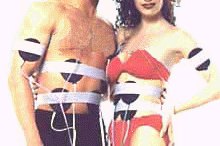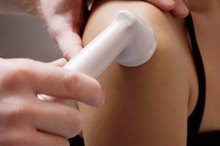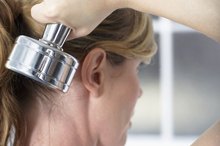How to Get Rid of Belly Fat Using a Muscle Stimulator
Abdominal muscle stimulators use light waves of electricity to engage the muscles. While electronic muscle stimulation is a staple for medical rehabilitation to keep a muscle group from atrophying due to a limb being immobilized, in recent years muscle stimulators are marketed as a way to flatten a fat belly. For a belly muscle stimulator to be effective, you must also engage in a regular workout routine and eat a healthy balanced diet.
Perform at least 150 minutes of moderately-intense cardiovascular exercise per week to help reduce fat cells throughout your body. Those who are slightly more advanced may only need to perform 75 minutes of intense cardio exercises per week; however, always start out a new workout program slowly to prevent injury or cardiac events, according to the Centers for Disease Control and Prevention. Examples of good cardiovascular exercise include jogging, swimming, brisk walking, aerobics and bicycling.
Muscle Testing for Allergies
Learn More
Increase muscle mass in your body by performing strength training exercises five days a week. Strength training exercises utilize an external weight to add resistance to specific muscle groups, which causes the muscles to fatigue. As the muscles repair themselves, its fibers become larger, thus increasing its size. ShapeFit states 1 lb. of muscle can burn 35 to 50 calories to simply sustain itself, thus the more muscle mass your body has the more calories are burned throughout the day. Speak with your physician regarding a safe strength training workout routine.
Read the directions on the muscle stimulator. The exact usage instructions will vary from product-to-product; however, most products require you to place a gel solution on the stimulator pads prior to placing the pads on your abdomen.
Things You Wear Around Your Waist to Get Rid of Belly Fat
Learn More
Place the electrical pads onto your abdominal region, and turn on the machine. Begin by choosing the low setting and gradually increase the intensity. Allow the stimulator to work according to the guidelines established in its owner’s manual. Never use the stimulator longer than suggested by the manufacturer. Continue to use the muscle stimulator on a daily basis in conjunction with cardiovascular and strength training exercises to help get rid of belly fat.
Tips
Speak with a fitness professional about abdominal muscle stimulators and ask for product recommendations.
Warnings
Never use a muscle stimulator for your abdominals if you have a pacemaker, as the electrical currents may disrupt the pulsations of the pacemaker.
Related Articles
References
Tips
- Speak with a fitness professional about abdominal muscle stimulators and ask for product recommendations.
Warnings
- Never use a muscle stimulator for your abdominals if you have a pacemaker, as the electrical currents may disrupt the pulsations of the pacemaker.
Writer Bio
Jonathan McLelland has been a professional writer since 2005. He has worked as a story writer and editor for the international sitcom, “Completing Kaden,” as well as a proposal writer for various production companies. McLelland studied communication and theater at St. Louis Community College.









